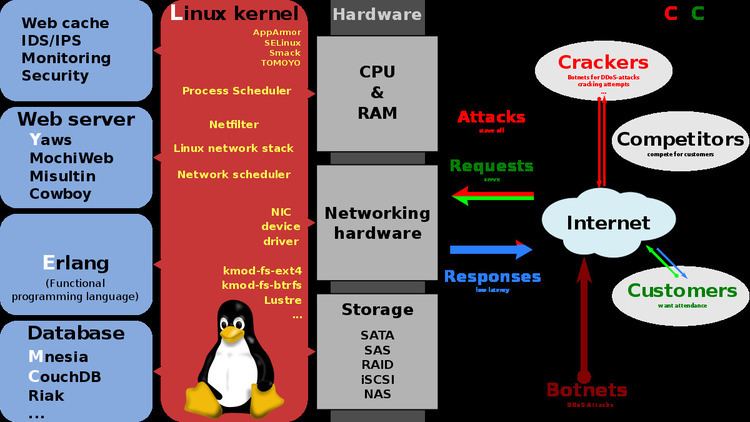Operating system | Platform Cross-platform | |
 | ||
Stable release 4.11 / January 23, 2014 (2014-01-23) Type Relational Database Management System | ||
Mnesia is a distributed, soft real-time database management system written in the Erlang programming language. It is distributed as part of the Open Telecom Platform.
Contents
Description
As with Erlang, Mnesia was developed by Ericsson for soft real-time distributed and high-availability computing work related to telecoms. It was not intended as a general office-based data processing database management system, nor to replace SQL-based systems. Instead Mnesia exists to support Erlang, where DBMS-like persistence is required. It has more in common with embeddable DBMS such as Berkeley DB than with a SQL database server.
Database model
"Rows" in tables are represented as records that contain a key value and a data field. This data field may in turn be a tuple containing an Erlang data structure of any complexity.
Relational features
The database model is relational, but isn't what someone familiar with SQL might expect. A database contains tables. Relationships between them are modelled as other tables.
A key feature of Mnesia's high-availability approach is that tables can be reconfigured within a schema and relocated between nodes, not only while the database is still running, but even while write operations are still going on.
Coding
The query language of Mnesia is Erlang itself, rather than SQL. It permits easy representation of transactions as a natural feature of Erlang by allowing developers to utilize a single language throughout an application.
Transactions
Erlang is a functional language. Mnesia builds on this to obtain ACID transaction support. The functional block which is run as a transaction is a commonplace Erlang construct called a Functional Object (or Fun) and is called by the single Mnesia statement mnesia:transaction(F). This can lead to clearer source code than the paired BEGIN / COMMIT syntax of SQL, and so avoids its problem of unclosed transactions within a procedure.
Again as a result of the functional nature of Erlang, nesting transactions is simple. It's also possible to distribute transactions across multiple nodes (i.e. separate servers). The semantics of using transactions in this way remains consistent, making it easy to write library code that works equally in either context.
General coding style for Mnesia will always use transactions. For performance reasons, it also supports deliberate "dirty operations" which avoid transactions. These compromise the atomicity and the isolation properties of ACID, but offer around 10× more throughput. In addition there are also in-memory alternatives, although these lose the durability property of ACID.
Efficient execution
Mnesia forms part of the LYME web application stack. This is akin to LAMP, but based on Erlang. Implementation in Erlang confers an efficiency benefit because of the use of a single virtual machine throughout an application. LYME makes use of this, since the Yaws web server is also implemented in Erlang.
Address space is shared (although safely so, under Erlang) between code and data, including Mnesia's table data.
Origins and licensing
Mnesia and Erlang were developed by the Ericsson Computer Science Laboratory. They have been released as open source software. Mnesia is released under a derivative of the Mozilla Public License. They are published according to the open source Erlang Public License.
ejabberd
Mnesia is also an option embedded within the Erlang-based Jabber daemon, ejabberd.
